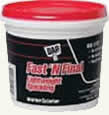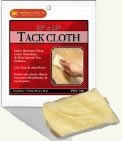- Use spackle or other patching compounds (Figure 6) to repair holes and cracks. In the case of very fine cracks you will have to widen them so that the patching compounds will actually fill the gaps. You cannot fill a hair line crack with any patching compound.
- Once you have filled all the holes and sanded the spackle you must invest the time and effort to remove off all remnants of the sanding dust. Start with a vacuum cleaner and then use a tack cloth (Figure 7) to finish. After you are sure you have removed all the sanding dust from the walls, ceiling and floor (you want it off the floor so that you do not tramp it through the rest of your home. As well, you will raise the dust up as you walk around the room painting), wipe the walls again!

Figure 6 - Spackling Compound
Use a putty knife (Figure 6b), not a scraper to lay the spackling compound. A putty knife has some flex in it and a scraper does not.

Figure 6b - Putty knife
Do not try to sand the spackling compound before it is completely dry!
Do not try to paint over the spackling compound before it is completely dry!
Additional information on repairing holes in drywall

Figure 7 - Tack Cloth
Any dust left behind will end up in the wet paint!
Buddy & Painting Parties:
Painting parties, having a friend or group of friends over to help paint, definitely makes the project go faster. However, there are some basic points you should remember if two or more people are painting in the same room.
- Paint different walls. Every person paints in a slightly different manner, leaving a little more or a little less paint on the walls as they paint. On adjacent walls the different style of painting will not be noticeable. On the same wall it is very possible that you will see the difference.
- Use paint from the same paint can on each wall. Using paint from different cans of paint on the same wall can lead to variations in paint tone.
Tips For Selecting Paint:
Choosing your paint can be a daunting exercise. You have 5 items to consider when choosing paint:
- Color
- Finish - the common finishes are high gloss, semi-gloss, eggshell, satin and flat.
- Flat (white) is normally used on ceilings.
- Eggshell and satin are the general purpose wall paint and is usually the choice for dens, bedroom, living, hallway, stairwell and family room walls.
- Semi-gloss or high gloss in kitchens and bathrooms, for its cleaning attributes. You may wish to consider a semi-gloss in children's bedrooms as it cleans easier than an eggshell.
- Trim is usually painted in a semi-gloss or high gloss because trim generally puts up with more abuse than walls.
- Base - although there are different base names the primary difference is whether they are water base or a solvent (oil) base. With water base (latex) paints all clean-up is accomplished using water. Whereas with solvent based paints you require the use of chemical solvents to clean brushes, rollers, trays and spills.
- Quality - there are definite quality differences in paint. The quality differences will present themselves in the number of coats required to cover old paint colors and in their ability to be washed. Quality paint manufactures offer a guarantee!
- Primer (undercoat) - there are a many primers on the market. My recommendation is that you use a primer made by the same company as the paint you are purchasing. There are two reasons. The first is that the manufactures test there paint using there own primers, hence the finishing paint will be compatible with the primer. The second reason is the guarantee. If you use the same make of paints for primer and finished coat there can never be an argument that the problem was the "other" manufacture.
Oil based paints are harder and provide a better surface for cleaning. As well, oil based paints have better contraction and expansion qualities which makes them less susceptible to cracking on wood trims and molding.
It is generally best to paint an entire room with the same type of base paint.
Areas that you have patched and areas that have not been previously painted should definitely have a primer or undercoat.
If you have doubts as to paint quality or matching primers and undercoats with finishing products I highly recommend that you visit a paint store to obtain your answers. Big box retailers use a lot of staff who may not have the expertise that you require. Paint stores exist only to supply paint products and hence have the knowledge to help.
